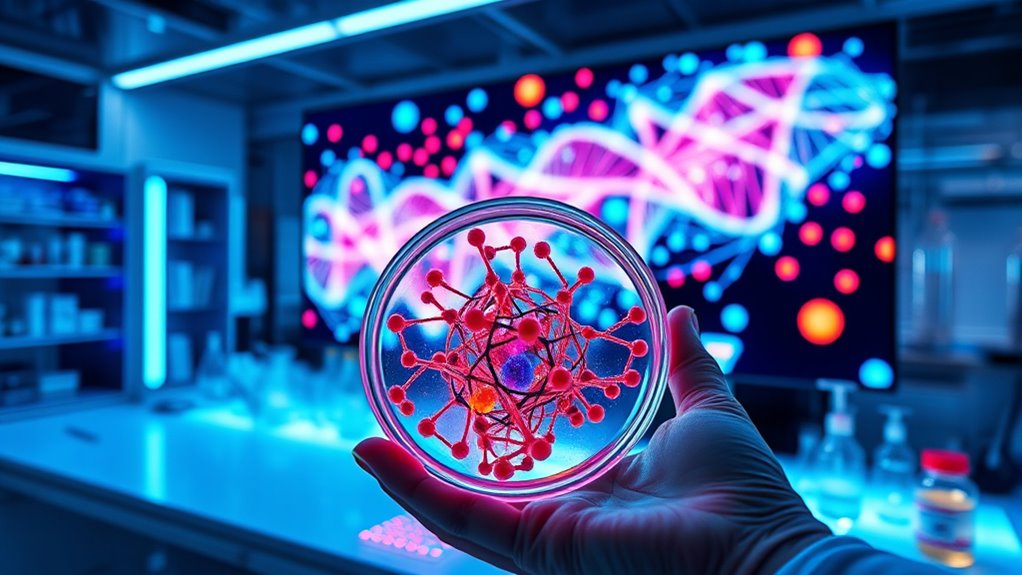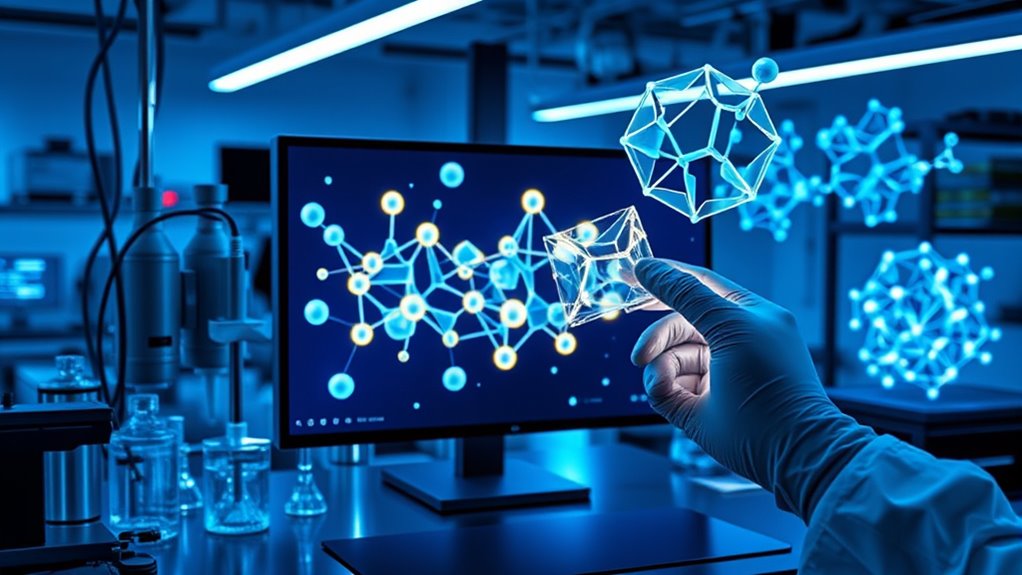AI-driven generative design is revolutionizing R&D by helping you rapidly discover and optimize molecules and materials. It analyzes large datasets to propose compounds with specific properties, reducing months of traditional research to just weeks. AI simulations predict behaviors and interactions, enabling you to focus on promising candidates quickly. This approach accelerates innovation and cuts costs. Explore further to see how these tools can transform your development process and open new scientific breakthroughs.
Key Takeaways
- AI-driven generative design accelerates molecular and material discovery by exploring vast chemical spaces efficiently.
- Neural networks analyze data to create molecules with desired properties, reducing research time from months to weeks.
- AI simulations predict material behavior, guiding experimental efforts toward the most promising candidates.
- Integration of real-time feedback tools enhances workflow efficiency and optimizes design iterations.
- Generative AI enables the development of innovative, sustainable materials with tailored mechanical, thermal, or electrical properties.

Have you ever wondered how artificial intelligence is transforming research and development? AI-driven techniques are revolutionizing the way scientists approach molecular optimization and material discovery. Instead of relying solely on trial-and-error or traditional methods, you can now harness the power of generative design to explore countless molecular configurations rapidly. This shift accelerates the discovery process, allowing you to identify promising compounds or materials more efficiently than ever before. By leveraging AI, you’re able to simulate how molecules behave, interact, and vary, providing insights that guide you toward ideal solutions in record time. This approach not only shortens research cycles but also reduces costs, opening new possibilities for innovation in pharmaceuticals, nanotechnology, and advanced materials.
When it comes to molecular optimization, AI algorithms analyze vast datasets to generate new molecular structures tailored to specific properties or functions. You input desired traits—such as increased stability, bioactivity, or conductivity—and the system predicts and proposes molecules that meet these criteria. This process transforms what used to take months or years into days or weeks, giving you a competitive edge in developing groundbreaking drugs or materials. Generative models, like deep neural networks, learn from existing molecular data, enabling them to propose novel structures that might never have been conceived through traditional chemistry alone. As a result, you’re empowered to push the boundaries of what’s possible, exploring chemical space with unprecedented depth and breadth.
Material discovery also benefits immensely from AI’s generative design capabilities. You can now design new materials with specific mechanical, thermal, or electrical properties by simulating how different compositions and structures behave under various conditions. This targeted approach allows you to focus your experimental efforts on the most promising candidates, markedly reducing the need for exhaustive testing. AI-driven models help you understand the relationships between structure and function at a fundamental level, guiding you toward materials that are lighter, stronger, more sustainable, or more efficient. Whether you’re developing next-generation batteries, lightweight composites, or biodegradable plastics, AI insights accelerate your innovation pipeline and improve your chances of success.
Additionally, integration of AI tools for real-time performance tracking can further optimize research workflows, ensuring continuous improvement and rapid iteration.
Frequently Asked Questions
How Does Generative Design Improve Molecule Discovery Speed?
Generative design accelerates molecule discovery by automating molecular optimization, allowing you to rapidly explore a vast chemical space. You can input desired properties, and the system generates numerous candidate molecules, reducing manual trial-and-error. This design automation speeds up identifying promising compounds, cutting down development time considerably. As a result, you achieve faster innovation, optimize molecules more effectively, and stay ahead in competitive research environments.
What Are the Main Challenges in Applying AI to Materials Science?
You face challenges like data privacy concerns, which limit access to all-inclusive datasets, and bias in training data, causing skewed results. Mitigating bias is essential for reliable predictions, but it requires careful curation and validation. Additionally, ensuring data privacy while sharing enough information for AI models is tricky. Overcoming these hurdles demands robust protocols and ethical standards to harness AI’s full potential in materials science.
How Reliable Are Ai-Generated Molecular Structures?
While AI-generated molecular structures seem promising, trustworthiness concerns still exist. You should validate these structures with experimental data and computational methods to guarantee accuracy. AI’s reliability varies, often depending on training data and algorithms. Although it can rapidly generate plausible models, you must remain cautious—validation methods are essential to confirm their practicality, making AI a helpful tool rather than an infallible solution.
Can AI Predict Long-Term Stability of New Materials?
AI can help predict the long-term stability of new materials through advanced predictive modeling. By analyzing data on similar substances, it estimates material lifespan and identifies potential degradation pathways. While AI provides valuable insights, it’s not foolproof and may require experimental validation. You should use AI predictions as a guide, combining them with real-world tests to ensure the durability and reliability of new materials over time.
What Ethical Considerations Arise From Ai-Driven R&D?
You need to consider data privacy when using AI-driven R&D to protect sensitive information from misuse. Bias mitigation is also essential to ensure your algorithms don’t reinforce stereotypes or unfairly favor certain outcomes. Ethically, you’re responsible for transparency and accountability, making sure your AI systems are fair and trustworthy. By addressing these issues, you promote responsible innovation and prevent potential harm caused by unchecked biases or data misuse.
Conclusion
You’re standing at the dawn of a new era where AI acts as a master sculptor, shaping molecules and materials with precision and creativity. With generative design, you can liberate hidden potential like a treasure hunter revealing gems beneath the surface. Embrace this technological symphony, and watch your innovations soar like shooting stars across the scientific sky. The future of R&D is yours to craft—bold, boundless, and brilliantly alive.









